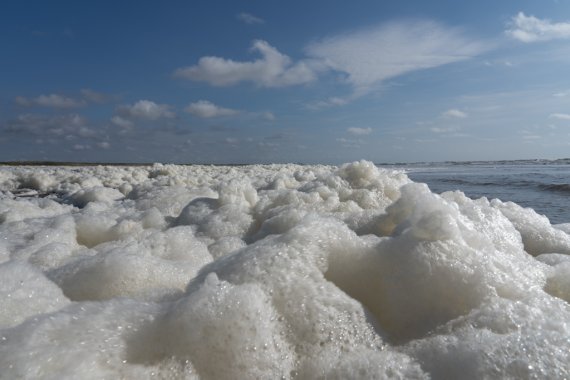These are the words of Jeroen Wijsman of Wageningen Marine Research. Wijsman studies Phaeocystis globosa – better known as the foam algae – that sometimes also cause damage to the muscle breeding farms. This alga has a peculiar way of life, says Wijsman. ‘Just like most algae in the North Sea, it is a unicellular organism. But in spring, when the alga blooms, they can form rotund colonies made up of thousands of cells, that use slime to stick together. Inside these colonies, they set up a collective supply of food, containing proteins and other nutrients.
Nutrients, in combination with sunlight, caused significant algae growth. Besides, the was a north-western wind, which blew the foam onto the beach
Jeroen Wijsman, researcher at Wageningen Marine Research
Light and nutrients
In the spring, when there are ample sunlight and nutrients available, the algae bloom. This usually occurs in April and May. When the algae lack food, towards the end of the blooming period, the colonies fall apart, and the proteins are released into the water. The wind and waves then whisk them into a thick foam, like cappuccino. Some years there is more foam on the beach than others; this depends on factors such as the number of algae in the water, but also the wind and its direction. The algae growth peaked during the seventies and eighties due to eutrophication (nutrients in the water), but the supply of nutrients from rivers has declined steeply over the past few decades.
High water
Each year, in the spring, the foam is visible. Fishers call this the May-suds. But the metres thick layer of foam that occurred now is quite unique, Wijsman states. A complex series of circumstances likely caused it. ‘April was an exceptionally sunny month, and the water levels in the rivers were high. The rivers that discharge in the sea contain large quantities of nutrients such as nitrogen and phosphate. Those nutrients and sunlight caused abundant algae growth. Furthermore, the north-western wind blew the froth onto the beaches. The northern pier at Scheveningen forms a funnel where the foam collects.’
Further research
The Royal Netherlands Institute for Sea Research (known by the Dutch acronym NIOZ), has been studying the foam algae and is currently analysing samples of the foam from Scheveningen. The researchers want to discover the exact composition if the foam, to gain insight into the circumstances that led to the disaster.

 Foam on the beach last weekend. Photo: Tessa Louwerens
Foam on the beach last weekend. Photo: Tessa Louwerens